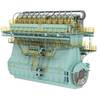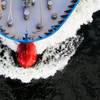Two employees of the COMSAT Mobile Communications (CMC) Land Earth Station in Southbury, Conn., were recognized recently by the United States Coast Guard (USCG) for coordinating life-saving satellite communications for the Coast Guard, the maritime vessel Ocean Wolf and four rescue ships.
The incident began around 6:30 p.m. EST on Monday, October 30, 2000, when the (USCG) Station in San Juan, Puerto Rico, contacted Southbury requesting assistance in communicating with Ocean Wolf, which had suffered an explosion in the engine room and was taking on water. Unknown at the time was the extent of damage and danger to the vessel — it was adrift and Tropical Storm Joyce was bearing down on its location.
Ocean Wolf was in the Atlantic Ocean, more than 420 miles east of the nearest land area — the Caribbean island of Guadeloupe, which was out of radio range and too far from Coast Guard ships to reach her quickly. COMSAT-C satellite service was the only means of communication available. COMSAT-C is a low-cost, digital messaging service used for telex and data applications such as e-mail, Global Positioning and Global Maritime Distress and Safety messages.
Theresa Edwards and Joe Wheelahan at CMC's Southbury earth station immediately began determining locations of ships near the Ocean Wolf and requested their assistance. After sending a "no cost safety message" and polling ships in the area, Edwards and Wheelahan determined there were four ships within three hours of reaching the distressed vessel. A short time later, the Thorsriver responded to the emergency and diverted to assist the Ocean Wolf.
"We knew the damage was serious and time was critical if we were going to be able to successfully coordinate help," said Wheelahan, who with Edwards, was working the night shift at the Southbury facility. "We assisted the Coast Guard by sending satellite messages that diverted the two closest ships that had the necessary onboard equipment to assist the Ocean Wolf," he added.
Coast Guard duty watchstander T. O'Brien of the San Juan Station noted that CMC's Southbury facility provided the critical communications link for the coordinated rescue effort that saved two lives aboard the Ocean Wolf.
According to Rick Kenney, Automated Mutual-assistance Vessel Rescue (AMVER) Maritime Relations Officer for the (USCG), "COMSAT Mobile's land earth stations have been a major element in providing critical communications in search and rescue efforts taken on by the Coast Guard. CMC's land earth stations have been on the receiving end of many emergency and distress communications that have resulted in Coast Guard rescue teams saving hundreds of lives at sea every year. We at AMVER have nothing but admiration for the staffs at CMC's land earth stations."
As one of their essential duties, the staffs at all of CMC's land earth stations, including Santa Paula, Calif.; Kuantan, Malaysia; and Southbury, are specially trained to coordinate emergency communications with international, federal and local safety, search and rescue organizations.
"It is very gratifying to hear that our efforts helped save two lives," Edwards said. "We coordinate mobile satellite communications for emergency situations quite a few times every week but very rarely hear back from the parties. We are happy that the Coast Guard let us know that we did make a difference with the Ocean Wolf."
Subscribe for
Maritime Reporter E-News
Maritime Reporter E-News is the maritime industry's largest circulation and most authoritative ENews Service, delivered to your Email five times per week













